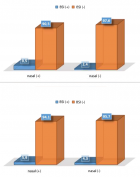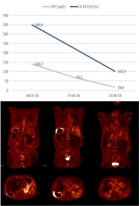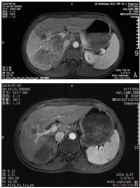Abstract
Research Article
Toxicity and Phytochemical Analysis of Five Medicinal Plants
Johnson-Ajinwo Okiemute Rosa*, Nyodee and Dummene Godwin
Published: 25 April, 2024 | Volume 8 - Issue 1 | Pages: 029-040
Recent studies have shown that long-term uses of herbs have been associated with a rise in morbidity and mortality rates. While most researches are focused on bioactivity investigations, the toxicity of many plants has not been reported. There is a paucity of data on the potential toxicity of the following plants: Harungana madagascariensis (HM), Pterocarpus osun (PO), Phoenix dactylifera (PD), Annona muricata (AM), and Rutidea parviflora (RP). To evaluate the toxicity of the above-mentioned plants; two tests were employed namely: The Brine shrimp lethality test (BSLT) and the Allium cepa test. A correlation between the oral acute toxicity assay in mice and the LC50 obtained from BSLT has been established. Allium cepa test measures the potential genotoxic effects of plant extracts exerted on the root meristem of A. cepa (onions). Plant extracts were administered in concentrations ranging from 100 to 2500 µg/ml to the A. cepa for 72 h to obtain their Mitotic Indices (MI) and EC50. Results of the MI at 2500 µg/ml for HM, PO, PD, AM, and RP were 3.75, 4.96, 5.96, 6.10, and 6.71 while 281.81, 398.11, 501.19, 630.96, and 707.9 µg/ml were obtained as the respective EC50 values. Furthermore, 10-1000 mcg/ml concentrations were administered in the BSLT and the obtained LC50 values were 116.3, 250, 581.5, 581.5, and 750 µg/ml. The toxicity result demonstrated that the five plants were moderately toxic, with RP exhibiting minimal toxicity values and thus potentially having a good safety profile. The phytochemical screening of these plants revealed the presence of some pharmacologically important classes of compounds that are abundant. Several bioactive and toxic compounds were identified in the GC-MS analysis for some of the plants.
Read Full Article HTML DOI: 10.29328/journal.apps.1001054 Cite this Article Read Full Article PDF
Keywords:
Genotoxicity; Cytotoxicity; BSLT
References
- Lombardi VR, Carrera I, Cacabelos R. In Vitro Screening for Cytotoxic Activity of Herbal Extracts. Evid Based Complement Alternat Med. 2017;2017:2675631. doi: 10.1155/2017/2675631. Epub 2017 Mar 13. PMID: 28386288; PMCID: PMC5366791.
- Hussain I, Ullah R, Ullah R, Khurram M, Ullah N, Baseer A, Khan FA, Khattak MR, Zahoor M, Khan J, khan N. Phytochemical analysis of selected medicinal plants. African Journal of Biotechnology. 2011; 10(38):7487-7492.
- Dar RA, Shahnawaz M, Qazi PH. General overview of medicinal plants: A review. 2017; 6(6):349–351.
- Agu KC, Okolie PN. Proximate composition, phytochemical analysis, and in vitro antioxidant potentials of extracts of Annona muricata(Soursop). Food Sci Nutr. 2017 Jun 29;5(5):1029-1036. doi: 10.1002/fsn3.498. PMID: 28948021; PMCID: PMC5608983.
- Gulumian M, Yahaya ES, Steenkamp V. African Herbal Remedies with Antioxidant Activity: A Potential Resource Base for Wound Treatment. Evid Based Complement Alternat Med. 2018 Nov 22;2018:4089541. doi: 10.1155/2018/4089541. PMID: 30595712; PMCID: PMC6282146.
- Avwioro OG, Aloamaka PC, Ojianya NU, Oduola T, Ekpo EO. Extracts of Pterocarpus osun as a histological stain for collagen fibres. African Journal of Biotechnology. 2005; 4(5):460-462.
- Biswas R, Mukherjee PK, Dalai MK, Mandal PK, Nag M. Tyrosinase inhibitory potential of purpurin in Rubia cordifolia—A bioactivity guided approach. Industrial crops and products. 2015; 74:319-326.
- Coria-Téllez AV, Montalvo-Gónzalez E, Yahia EM, Obledo-Vázquez EN. Annona muricata: A comprehensive review on its traditional medicinal uses, phytochemicals, pharmacological activities, mechanisms of action and toxicity. Arabian Journal of Chemistry. 2018; 11(5):662–691.
- Rady I, Bloch MB, Chamcheu RN, Banang Mbeumi S, Anwar MR, Mohamed H, Babatunde AS, Kuiate JR, Noubissi FK, El Sayed KA, Whitfield GK, Chamcheu JC. Anticancer Properties of Graviola (Annona muricata): A Comprehensive Mechanistic Review. Oxid Med Cell Longev. 2018 Jul 30;2018:1826170. doi: 10.1155/2018/1826170. PMID: 30151067; PMCID: PMC6091294.
- Ribeiro de Souza EB, da Silva RR, Afonso S, Scarminio IS. Enhanced extraction yields and mobile phase separations by solvent mixtures for the analysis of metabolites in Annona muricata L. leaves. J Sep Sci. 2009 Dec;32(23-24):4176-85. doi: 10.1002/jssc.200900375. PMID: 19882621.
- Chatrou LW, Erkens RHJ, Richardson JE, Saunders RMK, Fay MF. The natural history of Annonaceae. Botanical Journal of the Linnean Society. 2012; 169(1):1–4.
- Moghadamtousi SZ, Fadaeinasab M, Nikzad S, Mohan G, Ali HM, Kadir HA. Annona muricata (Annonaceae): A Review of Its Traditional Uses, Isolated Acetogenins and Biological Activities. Int J Mol Sci. 2015 Jul 10;16(7):15625-58. doi: 10.3390/ijms160715625. PMID: 26184167; PMCID: PMC4519917.
- Frausin G, Lima RBS, Hidalgo AF, Maas P, Pohlit AM. Plantas da familia annonaceae tradicionalmente usadas como antimaláricos: Uma revisão. Revista Brasileira de Fruticultura, 36(SPEC. EDITION 1). 2014; 315–337.
- Natsir HH, Soekamto NH. J. Phys. 2019; 32027.
- Badrie N, Schauss AG. Soursop (Annona muricata L.): Composition, nutritional value, medicinal uses, and toxicology. In Bioactive Foods in Promoting Health. 2010; 621–643.
- World Health Organisation. Plant Medicinal in Papua New Guinea World Health Organization press, Manila. 2008; 26–27.
- Longuefosse JL, Nossin E. Medical ethnobotany survey in Martinique. J Ethnopharmacol. 1996 Sep;53(3):117-42. doi: 10.1016/0378-8741(96)01425-0. PMID: 8887020.
- Ross IA. Medicinal plants of the world, volume 3: Chemical constituents, traditional and modern medicinal. Springer Science & Business Media. 2007; 3.
- Rahmani AH, Aly SM, Ali H, Babiker AY, Srikar S, Khan AA. Therapeutic effects of date fruits (Phoenix dactylifera) in the prevention of diseases via modulation of anti-inflammatory, anti-oxidant and anti-tumour activity. Int J Clin Exp Med. 2014 Mar 15;7(3):483-91. PMID: 24753740; PMCID: PMC3992385.
- Chao CCT, Krueger RR. The date palm (Phoenix dactylifera L.): Overview of biology, uses, and cultivation. HortScience. 2007; 42(5):1077–1082.
- Al-Harrasi A, Rehman NU, Hussain J, Khan AL, Al-Rawahi A, Gilani SA, Al-Broumi M, Ali L. Nutritional assessment and antioxidant analysis of 22 date palm (Phoenix dactylifera) varieties growing in Sultanate of Oman. Asian Pac J Trop Med. 2014 Sep;7S1:S591-8. doi: 10.1016/S1995-7645(14)60294-7. PMID: 25312188.
- Al-Alawi RA, Al-Mashiqri JH, Al-Nadabi MJS, Al-Shihi BI. Date Palm Tree (Phoenix dactylifera L.): Natural Products and Therapeutic Options. Frontiers in Plant Science | Www.Frontiers in. Org. 2017; 8:845.
- Hazzouri KM, Flowers JM, Visser HJ, Khierallah HSM, Rosas U, Pham GM, Meyer RS, Johansen CK, Fresquez ZA, Masmoudi K, Haider N, El Kadri N, Idaghdour Y, Malek JA, Thirkhill D, Markhand GS, Krueger RR, Zaid A, Purugganan MD. Whole genome re-sequencing of date palms yields insights into diversification of a fruit tree crop. Nat Commun. 2015 Nov 9;6:8824. doi: 10.1038/ncomms9824. PMID: 26549859; PMCID: PMC4667612.
- Barghini P, Di Gioia D, Fava F, Ruzzi M. Vanillin production using metabolically engineered Escherichia coli under non-growing conditions. Microb Cell Fact. 2007 Apr 16;6:13. doi: 10.1186/1475-2859-6-13. PMID: 17437627; PMCID: PMC1857700.
- Martín-Sánchez AM, Cherif S, Ben-Abda J, Barber-Vallés X, Pérez-Álvarez JÁ, Sayas-Barberá E. Phytochemicals in date co-products and their antioxidant activity. Food Chem. 2014 Sep 1;158:513-20. doi: 10.1016/j.foodchem.2014.02.172. Epub 2014 Mar 12. PMID: 24731377.
- Ahmed A, Bano N, Tayyab M. Phytochemical and Therapeutic Evaluation of Date (Phoenix dactylifera). A Review Phytochemical and Therapeutic Evaluation of Date (Phoenix dactylifera). 2016; 11–17.
- Glasner B, Botes A, Zaid A, Emmens J. Date harvesting, packinghouse management and marketing aspects. In: A. Zaid (ed.). Date palm cultivation. Food and Agriculture Organization Plant Production and Protection paper no. 156. Food and Agri Culture Organization of the United Nations, Rome, Italy. 2002; 177–208.
- Hadrami ElA, Al-Khayri JM. Socioeconomic and traditional importance of date palm. Emirates Journal of Food and Agriculture. 2012; 24(5):371–385.
- Shobayo BI, Ojo DA, Agboola DA. Antibacterial Activity of Pterocarpus osun L. on Multi-Drug Resistant (MDR) Escherichia coli from Wound Infections in Abeokuta, South-West Nigeria. OALib. 2015; 02(08):1-6.
- Gill LS. Ethno- medical uses of plants in Nigeria, University of Benin Press, Nigeria. 1992; 276.
- Abayomi O, Olakunle F, Simon O, Fausat A, Sunday T. Comparative Studies of Chemical Composition of the Leaf Extracts of Pterocarpus osun from Different Geographical Regions of Nigeria. American Journal of Ethnomedicine. 2015; 2(5):2348–9502.
- Osuagwu G, Akomas C. Antimicrobial activity of the leaves of three species of Nigerian Pterocarpus (Jacq.). International Journal of Medicinal and Aromatic Plants. 2013; 3:178-183.
- Ebi GC, Ofoefule SI. Antimicrobial activity of Pterocarpus osun stems. Fitoterapia. 2000 Aug;71(4):433-5. doi: 10.1016/s0367-326x(00)00130-1. PMID: 10925018.
- Ndjakou Lenta B, Ngouela S, Fekam Boyom F, Tantangmo F, Feuya Tchouya GR, Tsamo E, Gut J, Rosenthal PJ, Donald Connolly J. Anti-plasmodial activity of some constituents of the root bark of Harungana madagascariensis LAM. (Hypericaceae). Chem Pharm Bull (Tokyo). 2007 Mar;55(3):464-7. doi: 10.1248/cpb.55.464. PMID: 17329893.
- Antia BS, Ita BN, Udo UE. Nutrient Composition and In Vitro Antioxidant Properties of Harungana madagascariensis Stembark Extracts. J Med Food. 2015 May;18(5):609-14. doi: 10.1089/jmf.2014.0084. Epub 2015 Mar 18. PMID: 25785542; PMCID: PMC4410548.
- Oluwadunmi O, Adebiyi OE, Abatan MO, Adedapo AA. Methanol and diethyl stem bark extracts of Harungana madagascariensis blunt acetaminophen-induced liver damage in rats through its antioxidant property. Savannah Veterinary Journal. Savannah Veterinary. 2019; 2:1–4.
- Happi GM, Tiani GLM, Gbetnkom BYM, Hussain H, Green IR, Ngadjui BT, Kouam SF. Phytochemistry and pharmacology of Harungana madagascariensis: mini-review. Phytochemistry Letters, 35(November). 2019; 103–112.
- Shorinwa OA, Monsi B. Toxicological implications of the fruit of Harungana madagascariensis on Wistar rats. Clin Phytosci. 2020; 6:2.
- Irvine FR. Woody plants of Ghana. Woody plants of Ghana. Oxford University Press, London. 1961; 143-144.
- Olagunju JA, Oladunni SO, Oladimeji MS. Status of phosphatase activities in the liver and kidney of rats treated with isosaline leaf and stem-bark extracts of Harungana madagascariensis (L). Cytobios. 2000;103(402):17-24. PMID: 11030222.
- Prajapati ND, Purohit SS, Sharma AK, Kumar T. A handbook of medicinal plants: A complete sourcebook. In A handbook of medicinal plants: a complete sourcebook. 2003; 554-554.
- Okoli AS, Okeke MI, Iroegbu CU, Ebo PU. Antibacterial activity of Harungana madagascariensis leaf extracts. Phytother Res. 2002 Mar;16(2):174-9. doi: 10.1002/ptr.991. PMID: 11933123.
- Iwalewa EO, Suleiman MM, Mdee KL, Eloff NJ. Antifungal and antibacterial activities of different extracts of Harungana madagascariensis stem bark, Pharmaceutical Biology. 2009; 47(9):878-885.
- Kengni F, Fodouop SP, Tala DS, Djimeli MN, Fokunang C, Gatsing D. Antityphoid properties and toxicity evaluation of Harungana madagascariensis Lam (Hypericaceae) aqueous leaf extract. J Ethnopharmacol. 2016 Feb 17;179:137-45. doi: 10.1016/j.jep.2015.12.037. Epub 2015 Dec 22. PMID: 26721224.
- Johnson-Ajinwo OR, Richardson A, Li WW. Palmatine from Unexplored Rutidea parvifloraShowed Cytotoxicity and Induction of Apoptosis in Human Ovarian Cancer Cells. Toxins (Basel). 2019 Apr 25;11(4):237. doi: 10.3390/toxins11040237. PMID: 31027283; PMCID: PMC6521182.
- Burkill HM. The useful plants of West Tropical Africa. Vol. 1. Families AD (No. Ed. 2). Royal Botanic Gardens. 1985.
- Oberlies NH, Rogers LL, Martin JM, McLaughlin JL. Cytotoxic and insecticidal constituents of the unripe fruit of Persea americana. J Nat Prod. 1998 Jun 26;61(6):781-5. doi: 10.1021/np9800304. PMID: 9644064.
- Syahmi AR, Vijayarathna S, Sasidharan S, Latha LY, Kwan YP, Lau YL, Shin LN, Chen Y. Acute oral toxicity and brine shrimp lethality of Elaeis guineensis Jacq., (oil palm leaf) methanol extract. Molecules. 2010 Nov 10;15(11):8111-21. doi: 10.3390/molecules15118111. PMID: 21072022; PMCID: PMC6259233.
- Hisem D, Hrouzek P, Tomek P, Tomšíčková J, Zapomělová E, Skácelová K, Lukešová A, Kopecký J. Cyanobacterial cytotoxicity versus toxicity to brine shrimp Artemia salina. Toxicon. 2011 Jan;57(1):76-83. doi: 10.1016/j.toxicon.2010.10.002. Epub 2010 Oct 12. PMID: 20946912.
- Michael AS, Thompson CG, Abramovitz M. Artemia salina as a Test Organism for Bioassay. Science. 1956 Mar 16;123(3194):464. doi: 10.1126/science.123.3194.464. PMID: 17775415.
- Gajbhiye SN, Hirota R. Toxicity of heavy metals to brine shrimp Artemia. Journal of the Indian Fisheries Association. 1990; 20:43-50.
- Spielman A, Williams CM. Lethal effects of synthetic juvenile hormone on larvae of the yellow fever mosquito, Aedes aegypti. Science. 1966 Nov 25;154(3752):1043-4. doi: 10.1126/science.154.3752.1043. PMID: 5919758.
- McLaughlin JL, Rogers LL, Anderson JE. The use of biological assays to evaluate botanicals. Drug Information Journal. 1998; 32(2):513-524.
- Galsky AG, Wilsey JP. Crown Gall Tumor Disc Bioassay: A POSSIBLE AID IN THE DETECTION OF COMPOUNDS WITH ANTITUMOR ACTIVITY. Plant Physiol. 1980 Feb;65(2):184-5. doi: 10.1104/pp.65.2.184. PMID: 16661157; PMCID: PMC440294.
- Sarah QS, Anny FC, Mir M. Brine shrimp lethality assay. Bangladesh Journal of Pharmacology. 2017; 12(2):186-189.
- Levan A. The Effect of Colchicine on Root Mitosis in Allium. Hereditas. 1938; 24(4):471–486.
- Fiskesjö G. The Allium test as a standard in environmental monitoring. Hereditas. 1985;102(1):99-112. doi: 10.1111/j.1601-5223.1985.tb00471.x. PMID: 3988545.
- Rank J. The Method of Allium Anaphase-Telophase Chromosome Aberration Assay. Ekologija Vilnius. 2003 1:38-42.
- Bonciu E, Firbas P, Fontanetti CS, Wusheng J, Karaismailoğlu C, Liu D, Menicucci F, Pesnya DS, Popescu A, Romanovsky AV, Schiff S, Ślusarczyk J, De Souza CP, Srivastava A, Sutan A, Papini A. An evaluation for the standardization of the Allium cepa test as cytotoxicity and genotoxicity assay. Caryologia. 2018; 71(3):191-209.
- Bonea D, Bonciu E. Cytogenetic effects induced by the fungicide Royal Flo to maize (Zea mays L.), Caryologia. 2017; 70(3):195-199.
- Daphedar A, Taranath TC. Characterization and cytotoxic effect of biogenic silver nanoparticles on mitotic chromosomes of Drimia polyantha (Blatt. & McCann) Stearn. Toxicol Rep. 2018 Aug 31;5:910-918. doi: 10.1016/j.toxrep.2018.08.018. PMID: 30211013; PMCID: PMC6129697.
- Trease and Evans Pharmacognosy. 15th Ed, India: Elseiver. 2002; 191-393.
- Fiskesjo G. Allium test for screening chemicals; evaluation of cytological parameters. Plants for environmental studies. 1997; 11: 307-333.
- Grant WF. Chromosome aberration assays in Allium. A report of the U.S. Environmental Protection Agency Gene-Tox Program. Mutat Res. 1982 Nov;99(3):273-91. doi: 10.1016/0165-1110(82)90046-x. PMID: 7177154.
- Mohanka PR, Kumari P, Kumar B. Cytotoxicity Evaluation of Aqueous Extracts of Medicinal Plants. 2019; 5(2): 35-49.
- Haydar TF, Ang E Jr, Rakic P. Mitotic spindle rotation and mode of cell division in the developing telencephalon. Proc Natl Acad Sci U S A. 2003 Mar 4;100(5):2890-5. doi: 10.1073/pnas.0437969100. Epub 2003 Feb 14. PMID: 12589023; PMCID: PMC151436.
- Mazia D. Mitosis and the physiology of cell division. In The cel,l. 1961; 77-412. Academic Press.
- Nigg EA. Mitotic kinases as regulators of cell division and its checkpoints. Nat Rev Mol Cell Biol. 2001 Jan;2(1):21-32. doi: 10.1038/35048096. PMID: 11413462.
- Fiskesjö G. The Allium test--an alternative in environmental studies: the relative toxicity of metal ions. Mutat Res. 1988 Feb;197(2):243-60. doi: 10.1016/0027-5107(88)90096-6. PMID: 3340086.
- Fiskesjö G. The Allium test in wastewater monitoring. Environmental toxicology and water quality. 1993; 8(3): 291-298.
- Godwin A, Akinpelu B, Makinde A, Aderogba M, Oyedapo O. Identification of n-Hexane Fraction Constituents of Archidium ohioense (Schimp. ex Mull) Extract Using GC-MS Technique. British Journal of Pharmaceutical Research. 2015; 6(6): 366–375.
- Abubakar MN, Majinda RRT. GC-MS Analysis and Preliminary Antimicrobial Activity of Albizia adianthifolia (Schumach) and Pterocarpus angolensis (DC). Medicines (Basel). 2016 Jan 28;3(1):3. doi: 10.3390/medicines3010003. PMID: 28930113; PMCID: PMC5456228.
- Adegoke AS, Jerry OV, Ademola OG. GC-MS Analysis of Phytochemical Constituents in Methanol Extract of Wood Bark from Durio Zibethinus Murr. International Journal of Medicinal Plants and Natural Products. 2019; 5(3): 1-11.
- Ganesh M, Mohankumar M. Extraction and identification of bioactive components in Sida cordata (Burm.f.) using gas chromatography-mass spectrometry. J Food Sci Technol. 2017 Sep;54(10):3082-3091. doi: 10.1007/s13197-017-2744-z. Epub 2017 Jul 17. PMID: 28974793; PMCID: PMC5602971.
- Su Z, Wang P, Yuan W, Li S. Chemical constituents from Pterocarpus soyauxii. Nat Prod Commun. 2014 Oct;9(10):1483-6. PMID: 25522541.
- Rauter A, Ennis M, Hellwich K, Herold B, Horton D, Moss G, Schomburg I. Nomenclature of flavonoids (IUPAC Recommendations 2017). Pure and Applied Chemistry. 2018; 90(9): 1429-1486.
- Parveen Z, Nawaz S, Siddique S, Shahzad K. Composition and Antimicrobial Activity of the Essential Oil from Leaves of Curcuma longa L. Kasur Variety. Indian J Pharm Sci. 2013 Jan;75(1):117-22. doi: 10.4103/0250-474X.113544. PMID: 23901173; PMCID: PMC3719142.
- Pinto MEA, Araújo SG, Morais MI, Sá NP, Lima CM, Rosa CA, Siqueira EP, Johann S, Lima LARS. Antifungal and antioxidant activity of fatty acid methyl esters from vegetable An Acad Bras Cienc. 2017 Jul-Sep;89(3):1671-1681. doi: 10.1590/0001-3765201720160908. Epub 2017 Aug 31. PMID: 28876392.
- Yu FR, Lian XZ, Guo HY, McGuire PM, Li RD, Wang R, Yu FH. Isolation and characterization of methyl esters and derivatives from Euphorbia kansui (Euphorbiaceae) and their inhibitory effects on the human SGC-7901 cells. J Pharm Pharm Sci. 2005 Sep 27;8(3):528-35. PMID: 16401398.
- Abdel KM, Ezdehar A, Shaza A. Parkinsonia aculeate Oil: GC-MS Analysis and Antimicrobial Activity. The Pharmaceutical and Chemical Journal. 2019; 6(5): 35-39.
- Rivas da Silva AC, Lopes PM, Barros de Azevedo MM, Costa DC, Alviano CS, Alviano DS. Biological activities of α-pinene and β-pinene enantiomers. Molecules. 2012 May 25;17(6):6305-16. doi: 10.3390/molecules17066305. PMID: 22634841; PMCID: PMC6268778.
- Mondello F, De Bernardis F, Girolamo A, Cassone A, Salvatore G. In vivo activity of terpinen-4-ol, the main bioactive component of Melaleuca alternifolia Cheel (tea tree) oil against azole-susceptible and -resistant human pathogenic Candida species. BMC Infect Dis. 2006 Nov 3;6:158. doi: 10.1186/1471-2334-6-158. PMID: 17083732; PMCID: PMC1637110.
- Khaleel C, Tabanca N, Buchbauer G. α-Terpineol, a natural monoterpene: A review of its biological properties. Open Chemistry. 2018; 16(1): 349-361.
- Nithya M, Ragavendran C, Natarajan D. Antibacterial and free radical scavenging activity of a medicinal plant Solanum xanthocarpum. International Journal of Food Properties. 2018; 21(1): 313-327.
- Sreedharan S, Gothe A, Aier K, Shivasharanappa K, Kumar KP, Patil SJ. Bioactive Molecules and Antimicrobial Studies of Indian Traditional Medicinal Plant Rhus semialata Seeds. Research Journal of Medicinal Plants Research Article. 2020; 1819-3455.
- Semwal P, Painuli S, Badoni H, Bacheti RK. Screening of phytoconstituents and antibacterial activity of leaves and bark of Quercus leucotrichophora A. Camus from Uttarakhand Himalaya, Clin Phytosci. 2018; 4: 30.
Figures:
Similar Articles
-
Cytotoxic Effects of Aminotriles with Bioactive Potential: An Integrative ReviewPaola da Costa Vieira, Lettícia Tenório Cavalcanti, Hélida Maravilha Dantas e Sousa Almeida, Igor de Sousa Oliveira and Sávio Benvindo Ferreira*. Cytotoxic Effects of Aminotriles with Bioactive Potential: An Integrative Review. . 2023 doi: 10.29328/journal.apps.1001040; 7: 022-027
-
Toxicity and Phytochemical Analysis of Five Medicinal PlantsJohnson-Ajinwo Okiemute Rosa*, Nyodee, Dummene Godwin. Toxicity and Phytochemical Analysis of Five Medicinal Plants. . 2024 doi: 10.29328/journal.apps.1001054; 8: 029-040
Recently Viewed
-
Case Series of Metastatic Cutaneous Malignant Melanoma to the Gallbladder and the First Reported Case of Metachronous Adenocarcinoma of the ColonNourdin Kadi, Abid Chowdhury, Matthew Hanks, Abed M Zaitoun*. Case Series of Metastatic Cutaneous Malignant Melanoma to the Gallbladder and the First Reported Case of Metachronous Adenocarcinoma of the Colon. Ann Clin Gastroenterol Hepatol. 2024: doi: 10.29328/journal.acgh.1001044; 8: 001-005
-
A Rare Case of Uvulitis Following Endotracheal Intubation Using C- Mac Videolaryngoscope and How To Avoid ItKiran Kuruvilla George, Jini Chirackel Thomas, Krishnan B Sivaram, Krishna Prasad T*. A Rare Case of Uvulitis Following Endotracheal Intubation Using C- Mac Videolaryngoscope and How To Avoid It. Arch Pathol Clin Res. 2024: doi: 10.29328/journal.apcr.1001043; 8: 016-020
-
Autoantibodies in Autoimmune Addison’s Disease: Why are they Important?Maria Rosaria De Cagna, Norma Notaristefano, Maurizio Schiavone, Gianluca Palatella, Federica Ranù, Carmela Presicci, Valerio Cecinati, Marilina Tampoia*. Autoantibodies in Autoimmune Addison’s Disease: Why are they Important?. Arch Pathol Clin Res. 2024: doi: 10.29328/journal.apcr.1001042; 8: 012-015
-
Sinonasal Myxoma Extending into the Orbit in a 4-Year Old: A Case PresentationJulian A Purrinos*, Ramzi Younis. Sinonasal Myxoma Extending into the Orbit in a 4-Year Old: A Case Presentation. Arch Case Rep. 2024: doi: 10.29328/journal.acr.1001099; 8: 075-077
-
High-Performance Liquid Chromatography (HPLC): A reviewAbdu Hussen Ali*. High-Performance Liquid Chromatography (HPLC): A review. Ann Adv Chem. 2022: doi: 10.29328/journal.aac.1001026; 6: 010-020
Most Viewed
-
Evaluation of Biostimulants Based on Recovered Protein Hydrolysates from Animal By-products as Plant Growth EnhancersH Pérez-Aguilar*, M Lacruz-Asaro, F Arán-Ais. Evaluation of Biostimulants Based on Recovered Protein Hydrolysates from Animal By-products as Plant Growth Enhancers. J Plant Sci Phytopathol. 2023 doi: 10.29328/journal.jpsp.1001104; 7: 042-047
-
Sinonasal Myxoma Extending into the Orbit in a 4-Year Old: A Case PresentationJulian A Purrinos*, Ramzi Younis. Sinonasal Myxoma Extending into the Orbit in a 4-Year Old: A Case Presentation. Arch Case Rep. 2024 doi: 10.29328/journal.acr.1001099; 8: 075-077
-
Feasibility study of magnetic sensing for detecting single-neuron action potentialsDenis Tonini,Kai Wu,Renata Saha,Jian-Ping Wang*. Feasibility study of magnetic sensing for detecting single-neuron action potentials. Ann Biomed Sci Eng. 2022 doi: 10.29328/journal.abse.1001018; 6: 019-029
-
Pediatric Dysgerminoma: Unveiling a Rare Ovarian TumorFaten Limaiem*, Khalil Saffar, Ahmed Halouani. Pediatric Dysgerminoma: Unveiling a Rare Ovarian Tumor. Arch Case Rep. 2024 doi: 10.29328/journal.acr.1001087; 8: 010-013
-
Physical activity can change the physiological and psychological circumstances during COVID-19 pandemic: A narrative reviewKhashayar Maroufi*. Physical activity can change the physiological and psychological circumstances during COVID-19 pandemic: A narrative review. J Sports Med Ther. 2021 doi: 10.29328/journal.jsmt.1001051; 6: 001-007

HSPI: We're glad you're here. Please click "create a new Query" if you are a new visitor to our website and need further information from us.
If you are already a member of our network and need to keep track of any developments regarding a question you have already submitted, click "take me to my Query."
















































































































































